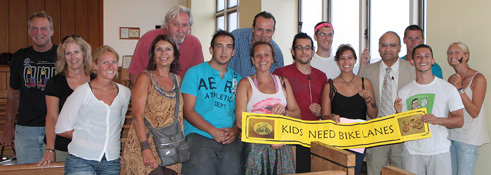Cyclists call for bike lanes
Residents pedal to City Council meeting to support proposal by Torres
On a typical Monday or Tuesday in the summer, a group of junior lifeguards can be found in front of Zamboni's Deli on West Park Avenue after their program ends for the day. Most, said Billy Papetti, 21, a lifeguard near Edwards Boulevard, ride their bikes, often navigating bustling summer streets.
“If there were [bike] lanes for them, it would be a lot safer because these kids are 10 to 12 years old,” Papetti said.
Papetti, who is also a member of Citizens United to Remove Barriers, or CURB, a local nonprofit that focuses on enhancing awareness of the needs of the physically challenged, said he often rides his bike to work, like many other lifeguards. The challenge, he said, is making it to the beach in one piece.
“Right now, we try to stay away from traffic-congested streets,” he said. “If we had bike lanes, it would be much safer for all of the riders.”
Papetti's wish could soon come true. Some city officials are pursuing an initiative that could make Long Beach more bicycle-friendly. Papetti was one of about 30 local bike enthusiasts who attended the July 20 City Council meeting — with bikes in tow — to support a proposal floated by City Councilman Len Torres that could lead to the creation of a series of bike lanes throughout the city.
Torres submitted an application to the U.S. Environmental Protection Agency on July 26 for a federal grant from the Climate Showcase Communities Grant Program, which is aimed at reducing greenhouse gas emissions and implementing climate-change initiatives. In Long Beach, Torres said, that would mean getting more people out of their cars and onto their bikes.
"That's really the key — to engage the ocean community to get around with bikes," he said. "The EPA wants to see how that's going to lower emissions, and that would be through lowering vehicle mileage around town."
Torres said that the application was submitted on behalf of the city through City Manager Charles Theofan's office. The grant would provide as much as $75,000 to fund a study to determine the safest areas in the city to build bike lanes, he explained.
“We're looking for the safest places to implement bike lanes, and I think Long Beach is ready for it,” Torres said, adding that he is working with Public Works Commissioner Kevin Mulligan. “People need to feel safe on their bikes. This is the beginning of a grant that we could put together that would result in some very good things for Long Beach that future generations could enjoy.”
The $75,000 includes a $50,000 contribution from the EPA. A $20,000 in-kind contribution would have to be kicked in by the city, but it would ultimately be reimbursed by the EPA. The Chamber of Commerce, Torres said, has pledged $5,000 for bike racks around the city.
“The money would be used to evaluate where bike lanes should be placed and the potential implementation of bike lanes throughout the city,” said Mulligan. “Depending on the results of this study, federal funding should be available to implement the lanes.”
Torres and others said that bike lanes would not only be environmentally friendly, but would help keep cyclists safe. Aside from the boardwalk, many residents who attended the meeting said, the city lacks adequate bike routes, and they called on the city to create safer lanes. “More than anything, it protects our kids,” said Board of Education Trustee Roy Lester, who rode his bike to the meeting. “So many kids ride their bikes to school. And so many more people would ride their bikes to the LIRR if it was safe.”
Torres said he met with city officials to obtain the data he needs for the completion of a request for proposals, including traffic flow information from the Police Department and information on communities that have implemented similar initiatives.
One of the main goals, he said, would be to create a series of “arterial” bike lanes that connect to the boardwalk and the central business district. He explained that he and other city officials are determining which streets could accommodate 3- to 4-foot-wide bike lanes, some of which could be marked off between the curb and street parking and would be safe for pedestrians as well. The study, he said, would take into account such factors as car passengers opening doors, in order to prevent injury to bike riders. In other areas, bike lanes would be demarcated alongside vehicular lanes.
For example, Torres said, on National, Washington and Lincoln boulevards, which have center islands, bike lanes could be added between the curb and the street, across from the islands, where cars are not permitted to park. "We're looking at the boulevards and key north-south routes all the way down to the president streets," he said. "At that point, we're looking at routes on Broadway through Neptune that could accommodate a lane all the way to the East End, to Lido Beach. We need to figure out how we can get a bike lane on the right side."
If approved, Torres said, the study would take six months to a year, and would include the costs of implementing such a project, which he said would be federally funded. He expects to receive a response from the EPA by October.
Ultimately, if the application is granted, a City Council resolution would be required to approve the construction of bike lanes, and the city would have to enter into an agreement with the EPA, Torres and Mulligan said.
Riders like Neil Monteko said bike lines would benefit the community. "This means having the opportunity to ride throughout the island safely," Monteko said. "I'm encouraged and glad to see there's an awareness."
Comments about this story? ARifilato@
liherald.com or (516) 569-4000 ext. 213.






